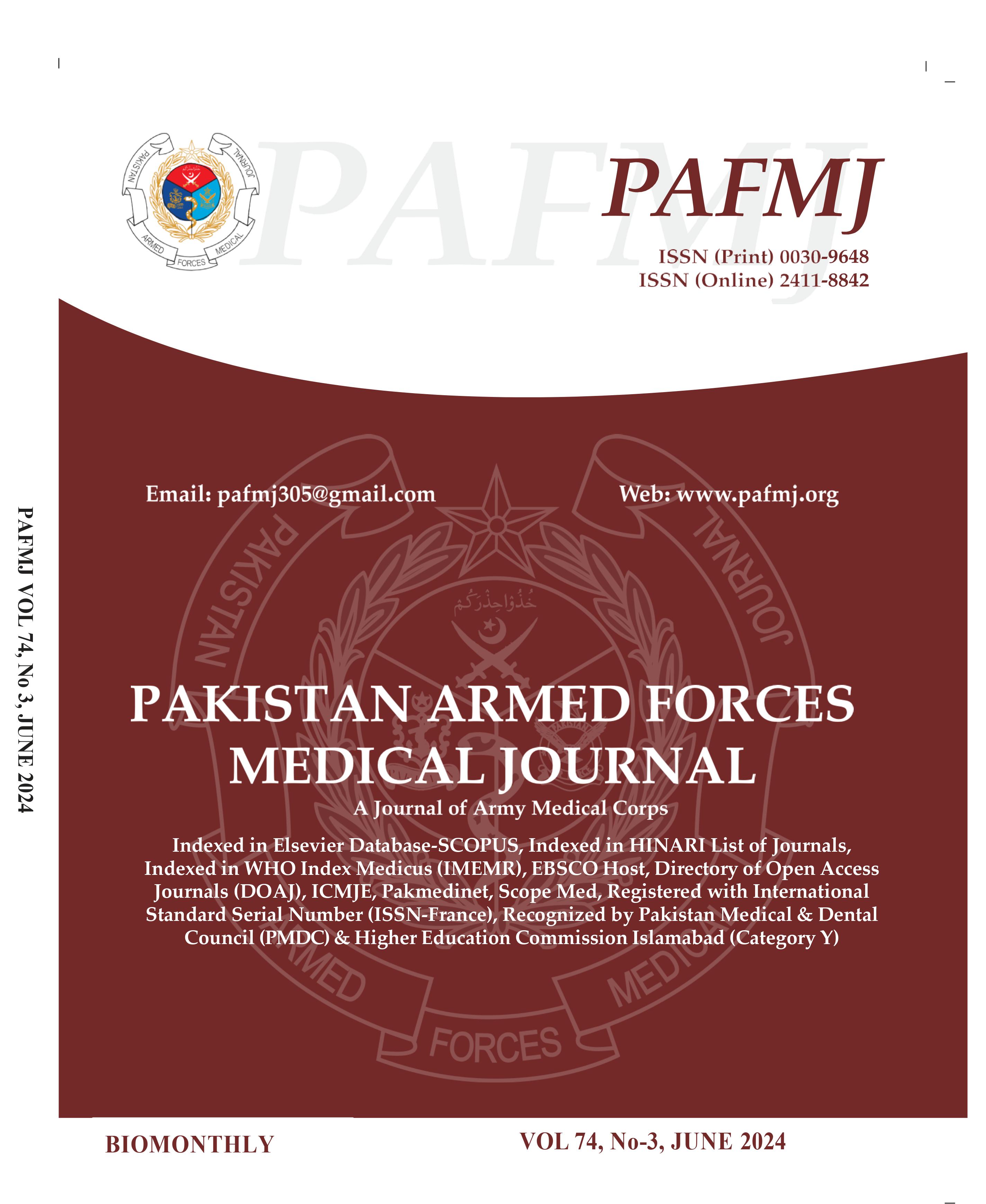Pattern of Healthcare-Associated Infections in a Tertiary Care Setting
DOI:
https://doi.org/10.51253/pafmj.v74i3.8000Keywords:
Antimicrobial Resistance, Bacterial Isolates, Health-Care-Associated InfectionsAbstract
Objective: To establish the frequency of emerging pathogens and their susceptibility profiles amongst various healthcare-associated infections.
Study Design: Cross-sectional study.
Place and Duration of Study: Department of Microbiology, Combined Military Hospital, Lahore Pakistan, from Jan to Dec 2020.
Methodology: One hundred and ninety-six samples with a history of hospital-acquired infections were received and processed following standard microbiological techniques. Antibiotic susceptibility testing was done by the Kirby-Bauer Disk Diffusion technique for the commonly used antibiotics. For colistin susceptibility, the Clinical and Laboratory Standards Institute recommends broth microdilution, colistin broth disk elution, or colistin agar testing MIC methods, however, colistin susceptibility was performed by the E-strip method.
Results: One hundred and ninety-six clinical samples with bacterial isolates causing healthcare-associated infections were processed. Specimens were from patients with surgical site infections (59,30.1%), Catheter-associated bloodstream infection (52, 26.5%); Ventilator-associated pneumonia (48, 24.5%) and Urinary tract infection (37,18.9%). Klebsiella pneumoniae (64, 32.7%), E.coli (51, 26%) and Acinetobacter baumanii (45,23%) were the leading bacterial pathogens. A total of 72(36.7%) isolates showed multidrug resistance whereas extensively drug-resistant isolates were calculated to be 124(63.3%).
Conclusion: High level of bacterial resistance amongst common health-care-associated infections is an eye-opener and impacts applying strict infection control measures along with antimicrobial stewardship. It will also help clinicians modify empiric treatment regimes in affected patients.
Downloads
References
. Garner JS, Jarvis WR, Emori TG, Horan TC, Hughes JM. CDC definitions for nosocomial infections. Am J Infect Control 1988; 16(3): 128-140. https://doi.org/10.1016/0196-6553(88)90053-3
Horan TC, Andrus M, Dudeck MA. CDC/NHSN surveillance definition of healthcare-associated infection and criteria for specific types of infections in the acute care setting. Am J Infect Control 2008; 36(5): 309-332.
https://doi.org/10.1016/j.ajic.2008.03.002
WHO-World Health Organization. Healthcare-associated infections FACT SHEET. [Internet]. Available at:
Horcajada JP, Montero M, Oliver A, Sorlí L, Luque S, Gómez-Zorrilla S, et al. Epidemiology and treatment of multidrug-resistant and extensively drug-resistant Pseudomonas aeruginosa infections. Clin Microbiol Rev 2019; 32(4): 31-19.
https://doi.org/10.1128/CMR.00031-19
Bi W, Liu H, Dunstan RA, Li B, Torres VV, Cao J, et al. Extensively drug-resistant Klebsiella pneumoniae causing nosocomial bloodstream infections in China: molecular investigation of antibiotic resistance determinants, informing therapy, and clinical outcomes. Front Microbiol 2017; 8: 1230.
https://doi.org/10.3389/fmicb.2017.01230
Salehi B, Goudarzi H, Nikmanesh B, Houri H, Alavi-Moghaddam M, Ghalavand Z. Emergence and characterization of nosocomial multidrug-resistant and extensively drug-resistant Acinetobacter baumannii isolates in Tehran, Iran. J Infect Chemother 2018; 24(7): 515-523.
https://doi.org/10.1016/j.jiac.2018.01.010
Kpokiri EE, Taylor DG, Smith FJ. Development of antimicrobial stewardship programmes in low and middle-income countries: a mixed-methods study in Nigerian hospitals. Antibiotics 2020; 9(4) :204.
https://doi.org/10.3390/antibiotics9040204
Amy LL. Clinical microbiology procedures handbook. American Society for Microbiology, Fourth Edition, John Wiley & Sons Inc; 2016.
CLSI. Clinical and Laboratory Standard Institute Performance Standards for Antimicrobial Susceptibility Testing, M100, 30th Edition. PA (USA): Wayne. Clinical and Laboratory Standards Institute; 2020.
Sweeney MT, Lubbers BV, Schwarz S, Watts JL. Applying definitions for multidrug resistance, extensive drug resistance, and pandrug resistance to clinically significant livestock and companion animal bacterial pathogens. J Antimicrob Chemother 2018; 73(6): 1460-1463.
https://doi.org/10.1093/jac/dky043
Parajuli NP, Acharya SP, Mishra SK, Parajuli K, Rijal BP, Pokhrel BM. High burden of antimicrobial resistance among gram negative bacteria causing healthcare associated infections in a critical care unit of Nepal. Antimicrob Resist Infect Control 2017; 6(1): 1-9.
https://doi.org/10.1186/s13756-017-0220-4
Bianco A, Capano MS, Mascaro V, Pileggi C, Pavia M. Prospective surveillance of healthcare-associated infections and patterns of antimicrobial resistance of pathogens in an Italian intensive care unit. Antimicrob Resist Infect Control 2018; 7(1): 1-6.
https://doi.org/10.1186/s13756-018-0323-4
Ali S, Birhane M, Bekele S, Kibru G, Teshager L, Yilma Y, et al. Healthcare associated infection and its risk factors among patients admitted to a tertiary hospital in Ethiopia: longitudinal study. Antimicrob Resist Infect Control 2018; 7(1): 9.
https://doi.org/10.1186/s13756-018-0328-z
Ben-Chetrit E, Wiener-Well Y, Lesho E, Kopuit P, Broyer C, Bier L, et al. An intervention to control an ICU outbreak of carbapenem-resistant Acinetobacter baumannii: long-term impact for the ICU and hospital. Crit Care 2018; 22(1): 319.
https://doi.org/10.1186/s13054-018-1980-7
Saleem Z, Hassali MA, Godman B, Hashmi FK, Saleem F. A multicenter point prevalence survey of healthcare–associated infections in Pakistan: findings and implications. Am J Infect Control 2019; 47(4): 421-424.
https://doi.org/10.1016/j.ajic.2018.09.014
Khan FU, Fang Y, Khan Z, Khan FU, Malik ZI, Ahmed N, et al. Occurrence, associated risk factors, and treatment of surgical site infections in Pakistan. Eur J Inflamm 2020; 18: 2058739220960547.
https://doi.org/10.1177/2058739220960547
Arif S, Sadeeqa S, Saleem Z, Latif S, Sharif M. The burden of healthcare-associated infections among pediatrics: a repeated point prevalence survey from Pakistan. Hosp Pract 2021; 49(1): 34-40. https://doi.org/10.1080/21548331.2021.1873075
Weiner-Lastinger LM, Abner S, Edwards JR, Kallen AJ, Karlsson M, Magill SS, et al. Antimicrobial-resistant pathogens associated with adult healthcare-associated infections: summary of data reported to the National Healthcare Safety Network, 2015–2017. Infect Control Hosp Epidemiol 2020; 41(1): 1-8.
https://doi.org/10.1017/ice.2019.296
Gashaw M, Berhane M, Bekele S, Kibru G, Teshager L, Yilma Y, et al. Emergence of high drug resistant bacterial isolates from patients with health care associated infections at Jimma University medical center: a cross sectional study. Antimicrob Resist Infect Control 2018; 7(1): 138.
Downloads
Published
Issue
Section
License
Copyright (c) 2024 Anam Tariq, Irfan Ali Mirza, Qanita Fahim, Fatima Hameed, Ayesha Khalid, Ambar Ashfaq

This work is licensed under a Creative Commons Attribution-NonCommercial 4.0 International License.















